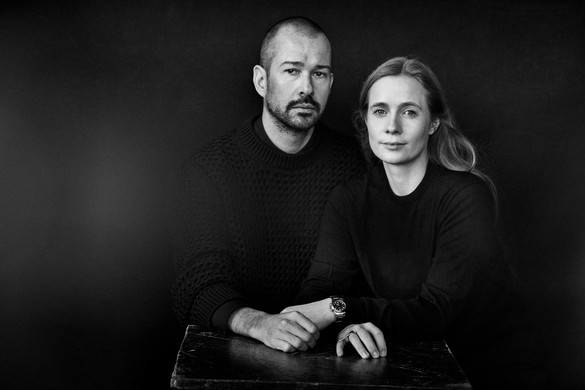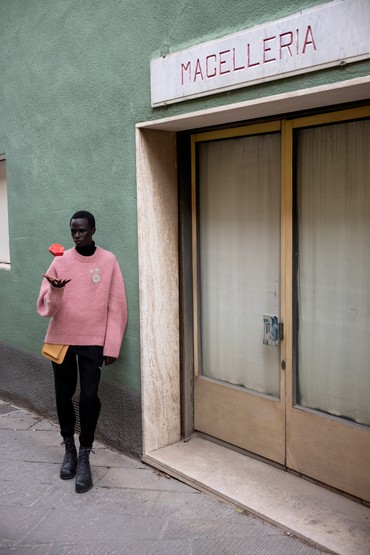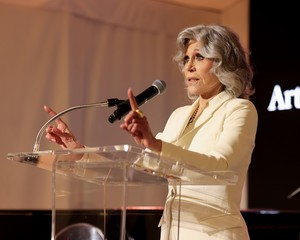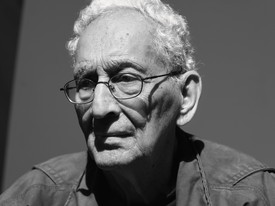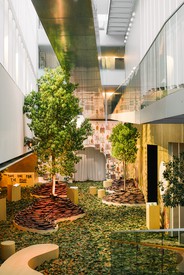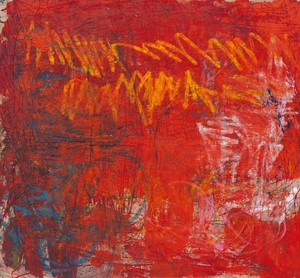
Wyatt Allgeier is a writer and an editor for Gagosian Quarterly. He lives and works in New York City.
Wyatt AllgeierLucie and Luke, I’d love to hear about both of your interests, generally, in the world of visual art. Have museums and galleries, or particular artists, been important in your approach at Jil Sander? What other areas of visual culture do you look to for inspiration?
Lucie and Luke MeierOur interests in visual art are quite eclectic. Since our work, too, is to create things, we are naturally drawn to technique as well as the feeling and the emotion evoked by the work. We try to understand the mediums selected and why artists utilize materials the way that they do in order to transmit feelings or concepts.
Experiencing Richard Serra’s work, we are always drawn to the powerful shapes he creates—the volumes, the feeling of traveling through the work. He’s a favorite. Gerhard Richter is too, for his technique: a master. Pablo Picasso and Louise Bourgeois, for their vast bodies of work—just remarkable output at such a consistently high level. Cy Twombly, for his humanity and his gestures. Noah Davis, for beauty. Rudolf Stingel, Lucie Rie, Ed Ruscha, Theaster Gates, Donald Judd, Dan Flavin, Kerry James Marshall, Anne Imhof, Matthew Barney, David Hammons, Agnes Martin, Robert Gober, Barry McGee, Pamela Rosenkranz, Cai Guo-Qiang, and many others have been an inspiration.
We absolutely look at art for inspiration. In a certain sense art is a freer form of expression than the work we do, as artists are not restricted by the scale of the human body. It’s wonderful to feel an emotion through someone’s work, perhaps delivered in a way that you wouldn’t expect. The transmission of emotion through images, through shapes and materials, is what we try to do with our work, and experiencing art grants us opportunities to feel this from other places. We also look at film and photography, as well as performance.
WAFor the most recent Jil Sander campaign, for the Fall/Winter 2021 collection, you’ve partnered with Joel Meyerowitz. How did you first become aware of his photography practice?
L&LMWe’ve been looking at Joel’s work for many, many years. We’ve seen various exhibitions of his photography, and his work has constantly recurred in our conversations. Ever since we started at Jil Sander, we'd wanted to have him work on a project with us, and finally the concept, timing, and logistics all worked out. It was a nice coincidence that he is also living and working in Italy, so it was a somewhat local project for us.
“Tuscany: Documented by Joel Meyerowitz.” Video: courtesy Jil Sander
WAAnd what about his work made you think he’d be the right fit for this particular collection?
L&LMHe could work with any collection of ours, he is that versatile and talented. It was incredible to see him work and how particular his eye was when it came to light. This collection is particularly strong in terms of materiality and we really wanted to work with light to show the depth of the garments. Joel is an absolute master of lighting.
WACould you tell us about the collaborative process with Joel? How were locations scouted? What was the casting process like? How involved were all parties in selecting the final edit?
L&LMThe process throughout was very collaborative. Joel was insistent that we would work together closely to reach the right feeling. Since the shoot was in an area of Tuscany that he knew very well, he scouted and sent photos and proposals, which we then discussed together. Once on-site, we spent a day walking around together and finalizing the road map. For casting, we sent Joel the proposals of who we wanted to work with and then had a conversation. Editing was the same: we had a long dialogue together about which photos to use.
WADo you have plans to collaborate with other photographers moving forward?
L&LMWe are always open to working with outstanding creative people. This is the joy of our job. We find it satisfying to develop our vision of Jil Sander along with contributors who can bring something of their own approach to the work.
WAJil Sander has recently opened a stunning pop-up shop on Greene Street in New York. The design is powerful and elegant. Could you tell us about the inspiration for the space and how it functions in relation to other projects?
L&LMThe initial starting point was to create a serene and transportive space. We were inspired to build shapes as well as flat surfaces in the same color and finish, blurring the boundaries between the space and the functional objects within it. There will be two additional installations.
WACould you tell us about any future projects or collaborations that you’re working on for Jil Sander?
L&LMWe’re working on several new architectural projects, which will be revealed to the public soon.
Photos: courtesy Jil Sander
